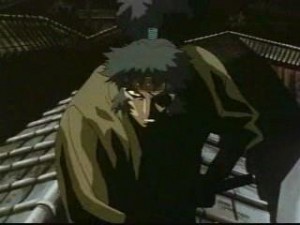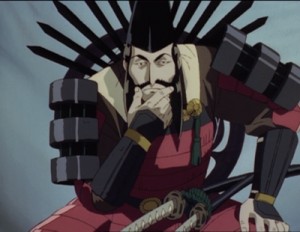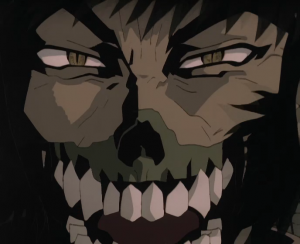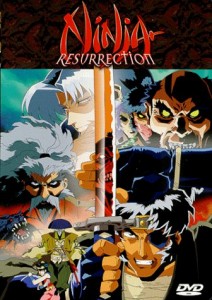Makai Tensho: Jigoku-hen (Demonic Resurrection: Portrait of Hell; Ninja Resurrection), directed by Yasunori Urata. Two 40-minute episodes. February 27, 1997 to March 27, 1998.
 Ninja Resurrection was another OAV for which the viewer had better really know Japanese history of the 17th century; especially of the Shimabara rebellion of Japanese Christians, and the legends about Jubei Yagyū, the “super samurai”. Legends then and popular literature today have constantly featured these two, separately and together.
Ninja Resurrection was another OAV for which the viewer had better really know Japanese history of the 17th century; especially of the Shimabara rebellion of Japanese Christians, and the legends about Jubei Yagyū, the “super samurai”. Legends then and popular literature today have constantly featured these two, separately and together.
In America where the distinction between authentic Japanese history and modern literary creations is confusing, the 94-minute 1993 theatrical movie Ninja Scroll, brought to America on video in 1996, established the mythology around Jubei Yagyū and the Shimabara rebellion. When the OAV Ninja Resurrection: The Revenge of Jubei came out two years later – it was released in America by A.D.V. in November 1998 – it was widely assumed by American fans to be an authorized sequel to Ninja Scroll. Fans were not just disappointed; they felt betrayed by the sharp drop in production quality from theatrical animation to animation that was poor even by OAV standards; by no apparent and contradictory plot connections between parts 1 and 2; and by the cliffhanger ending(s) that were never resolved.
Part 1: A lone samurai in a field is surrounded by enemy samurai. They draw glowing swords. He charges. Bloody heads and arms fly.
In the dojo of Tajima-no-Kami, the Yagyū home in Edo, Jubei’s father Munenori berates him for killing despite being ordered not to. He protests that he had no choice. His father orders him to fight and “show no mercy”, and deliberately blinds him with a throwing dart before banishing him from Edo, the shōgunate’s capital, to the Yagyū ancestral castle in Nara. (The Yagyū were the shōguns’ original personal swordmasters and tutors. According to legend, Jubei’s father accidentally blinded him during a dueling practice session; and after being banished, Jubei wandered throughout Japan, dueling wherever he went. Contemporary records indicate that he traveled throughout Japan by his own volition, not because he was banished from the shōgun’s court. Contemporary portraits show him with both eyes. The Yagyū clan may have deliberately created the legends to make themselves seem more mysterious and invincible.)
 The first of the two OAVs, Hell’s Spawn, begins “several months after the Shimabara riot”. (That was in 1637-1638.) An elderly traveling samurai and his retainer see two children, older sister Onui and younger brother Yataro, playing in a stream. Jubei relaxes near them.
The first of the two OAVs, Hell’s Spawn, begins “several months after the Shimabara riot”. (That was in 1637-1638.) An elderly traveling samurai and his retainer see two children, older sister Onui and younger brother Yataro, playing in a stream. Jubei relaxes near them.
The samurai, Lord Jushi Sekiguchi, is horrified that Jubei, the head of the Yagyū rural castle, has allowed it to fall into such disrepair. Jubei feels that it’s no longer needed. “The Tokugawa regime is extremely stable. War is a thing of the past.”
At dinner, Lord Jushi tells them that he has come to take Ohina, a teenaged girl, and his own daughter Onui to the shōgun Lord Yorinabu’s castle in Kishu. Tomboyish Onui doesn’t want to go, but they have no choice. Lord Yorinabu has ordered all unmarried daughters of noble families between 15 and 22 years old to be brought to his Wakayama castle. Jushi says uneasily that Lord Yorinabu is gathering masterless samurai into an army, and intends to increase taxes sharply. As they leave after a martial-arts demonstration won by Ohina and Onui, Jubei privately tells his retainer Tessai Yamanaka to have the Yagyū spy in Kishu watch Wakayama Castle closely, and to watch Yagyū Castle while he is gone for a few days.
All right; viewers need to know about the background of the Shimabara rebellion and its legends to appreciate the rest of the OAV:
During the late 1500s and early 1600s, Christian missionaries among the Portuguese, Spanish, and Dutch traders converted thousands of Japanese. When the Tokugawas established the shōgunate in 1603 and began to seal Japan against foreign influences, they were especially wary of the Christians; especially the Catholics, who they knew were conquering the Philippines “for Christ”, the Pope, and the King of Spain. The Japanese government under the shōguns wiped out most of Christianity during the 1620s and early 1630s.
In 1637 the Shimabara rebellion broke out. Read the Wikipedia entry for what really happened. Jubei Yagyū was not there, though Musashi Miyamoto was. Its importance here is that many of the Christians left in Japan were in Shimabara and joined the revolt, and were slaughtered after the rebels lost. Because most Japanese were non-Christian and believed in demons, it was easy for the shōgunate to spread the rumors that the Christians had been really devil-worshippers who were trying to spread Satanism in Japan. One of these rumors was that the Christians were raising many famous samurai who had been killed in battle and now controlled them as zombies for Satan. These legends spread over 200+ years, and combined with the legends of Jubei Yagyū as a wandering super-samurai.
This (above) what the writers of Ninja Resurrection based their scenario upon. Japanese viewers would be familiar with this, like Americans with the history of the 1861-1865 Civil War. American viewers weren’t.
In Edo, Jubei’s father Munenori learns from his ninja spy Godaiyu that demons and zombies are gathering at Lord Shosetsu Yui’s home. Godaiyu says that they could use Jubei, but Munenori angrily forbids him to mention Jubei’s name again.
 Jubei, wandering (presumably towards Edo), comes to a hut-home of an old monk whom he knows. Jubei is worried about “the prophecy of Tenshi”, that the Christians and their Lord Shirō killed at Shimabara will be reborn as Satanists. The monk is confidant that won’t happen, but says that Jubei is too young to retire to Yagyū Castle and give up warfare. Jubei reminds him of invincible samurai Musashi Miyamoto, who has retired to become a hermit. The elderly Musashi is shown, remembering the fighting at Shimabara and wondering if he could defeat Jubei today.
Jubei, wandering (presumably towards Edo), comes to a hut-home of an old monk whom he knows. Jubei is worried about “the prophecy of Tenshi”, that the Christians and their Lord Shirō killed at Shimabara will be reborn as Satanists. The monk is confidant that won’t happen, but says that Jubei is too young to retire to Yagyū Castle and give up warfare. Jubei reminds him of invincible samurai Musashi Miyamoto, who has retired to become a hermit. The elderly Musashi is shown, remembering the fighting at Shimabara and wondering if he could defeat Jubei today.
The Satanists, including Lord Shosetsu and someone later seen in part 2 as Sōiken Mori, resurrect a zombie army. Their zombies prepare to kill everyone. It ends on a cliffhanger with the Christians/Satanists and their zombies about to take over Japan.)
Part 2, The Cant of Hell, seems to contradict Part 1. It begins on December 25, 1628, setting up the Shimabara rebellion of ten years later – or the legend that it was a revolt of only Japan’s Christians, who were trying to create the Second Coming of Christ; but after losing the rebellion, they turned to trying to create the rebirth of Satan.
 A caption says “February 28, 1683”. This is completely nonsensical – that’s 45 years after the Shimabara rebellion, and 33 years after Jubei Yagyū’s death. But the OAV continues the legend of Christianity, led by teenaged Lord Shirō Amakusa Tokisada, growing during the 1630s and leading to the Shimabara rebellion.
A caption says “February 28, 1683”. This is completely nonsensical – that’s 45 years after the Shimabara rebellion, and 33 years after Jubei Yagyū’s death. But the OAV continues the legend of Christianity, led by teenaged Lord Shirō Amakusa Tokisada, growing during the 1630s and leading to the Shimabara rebellion.
An army of the Tokugawa shōgunate is wiped out during a heavy fog. Inside besieged Harano Castle, 16-year-old Lord Shirō’s military advisor Sōiken Mori whips the Christian peasants into a bloodlust, but Lord Shirō counsels showing Christian charity toward their oppressors. Lord Matsudaira Nobutsuna, the Tokugawa general, asks how they are to conquer Harano Castle? Jubei Yagyū, the leader of the Tokugawa ninja, says to leave it to him.
Lord Shirō and Sōiken Mori discuss their situation. Despite their strong situation, they are out of food and are all starving. Lord Shirō plans to offer to surrender, meaning his execution (actually he offers to commit seppuku), if the Tokugawa armies promise to spare the women and children. Sōiken refuses to allow it; he insists that they continue holding out. Shirō says that will mean that they will eventually all be killed. Sōiken says, “Exactly!”
 Jubei and a small band of Yagyū ninja fly over Harano Castle on large kites and drop into it. They kill all the defending soldiers and enable the Tokugawa army to enter the Castle. Musashi Miyamoto is among the Tokugawa conquerors. The Christian peasants and children retreat to the chapel where Lord Shirō pledges that they will be safe, because Christian magic will not allow non-Christians to enter. But Jubei and his ninja snuff out the Christian safeguards one by one. Shirō goes to confront Jubei, leaving Sōiken in charge of the chapel. As soon as he leaves, Sōiken murders everyone.
Jubei and a small band of Yagyū ninja fly over Harano Castle on large kites and drop into it. They kill all the defending soldiers and enable the Tokugawa army to enter the Castle. Musashi Miyamoto is among the Tokugawa conquerors. The Christian peasants and children retreat to the chapel where Lord Shirō pledges that they will be safe, because Christian magic will not allow non-Christians to enter. But Jubei and his ninja snuff out the Christian safeguards one by one. Shirō goes to confront Jubei, leaving Sōiken in charge of the chapel. As soon as he leaves, Sōiken murders everyone.
Shirō and Jubei meet on the castle rooftop. Shirō makes his offer to die if Jubei promises to spare the women and children. Jubei promises, but just as Shirō is about to commit seppuku, Sōiken appears with the heads of two children and accuses Jubei of having treacherously killed them. Shirō, horrified, feels that Jubei and the Christian god have betrayed him. He pledges himself to Satan, Sōiken’s true master. He summons a dragon and attacks Jubei. Jubei appears to win, and the OAV ends with him walking past Musashi Miyamoto. “To be continued” – but they lied. There was never another sequel.
Part 2 seems to take place before part 1. Were these released in reverse order in Japan?
Unlike the previous OAVs in this column, parts 1 and 2 of Ninja Resurrection are separate. Watch part 1 and then watch part 2. Or part 2 and then part 1; they seem to make more sense that way.
Part 1
Part 2
Next week: “Forgotten” OAVs #32.


 Fred Patten (1940-2018) was an internationally respected comics and animation historian. He has written about anime or comic books for publications ranging from Animation Magazine and Alter Ego to Starlog. He was a contributor to The Animated Movie Guide (2005), and is author of Watching Anime, Reading Manga (2004, Stone Bridge Press), a collection of his best essays, and Funny Animals and More (2014, Theme Park Press), based upon his early columns here on Cartoon Research. He passed away on November 12th, 2018.
Fred Patten (1940-2018) was an internationally respected comics and animation historian. He has written about anime or comic books for publications ranging from Animation Magazine and Alter Ego to Starlog. He was a contributor to The Animated Movie Guide (2005), and is author of Watching Anime, Reading Manga (2004, Stone Bridge Press), a collection of his best essays, and Funny Animals and More (2014, Theme Park Press), based upon his early columns here on Cartoon Research. He passed away on November 12th, 2018.





































There were also several live action adaptations of the original novel. These were all released in the U.S. on DVD. My favorite is Fukasaku’s movie starring Sonny Chiba.
Makai Tensho: Samurai Reincarnation (魔界転生 Makai Tenshō?, 1981) starring Sonny Chiba, directed by Kinji Fukasaku.
Reborn from Hell: Samurai Armageddon (魔界転生 Makai Tenshō?, 1996 direct-to-video) directed by Kazumasa Shirai.
Reborn from Hell II: Jubei’s Revenge (魔界転生 魔道変 Makai Tenshō: Madō-hen?, 1996 direct-to-video) directed by Kazumasa Shirai.
Samurai Resurrection (魔界転生 Makai Tenshō?, 2003) directed by Hideyuki Hirayama.